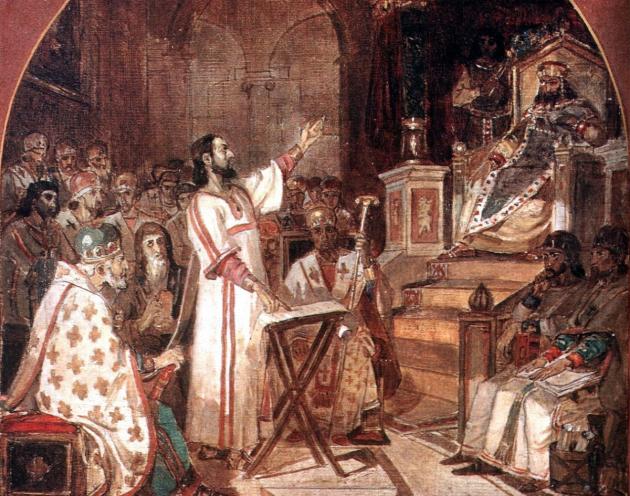I have just finished reading a volume published in 2017 entitled, In Search of Ancient Roots: The Christian Past and the Evangelical Identity Crisis by the Presbyterian author Kenneth J. Stewart. Dr. Stewart is, as the title of his book suggests, distressed at the modern phenomenon of Evangelicals leaving Evangelical churches to become Roman Catholics or Orthodox in their search for more ancient roots. He writes from the Reformed perspective, being the author of such books as Ten Myths About Calvinism and the Encyclopedia of the Reformed Faith. His book is a scholarly presentation of much Protestant history and is not overly polemical. My old Orthodox nose could, I think, sniff out at least a whiff of ecclesiastical desperation in the project.
His main contention is that Evangelicalism has enough ancient roots of its own so that Evangelicals need not abandon it for Rome or Antioch. (The identification of Orthodoxy with Antioch stems from the popularity of works such as Becoming Orthodox by the late Fr. Peter Gillquist; as a priest of the OCA I tried overlook the unintentional myopia.) Stewart rejects the charge that Evangelicals neither know nor care much about the Fathers and the first 1500 years of Church history. On the contrary, he contends that Evangelicals were formerly in the forefront of patristic scholarship.
Here’s where the whiff of desperation can first be found, for in order to make his case, he has to perform some historical sleight-of-hand and define as “Evangelicals” figures from the Protestant past such as Bishop Jewell, a Church of England prelate who died in 1571, or John Wycliffe, who died in 1384. That, I suggest, represents some sleight-of-hand, but it is typical of his entire argument. He consistently focuses upon figures of the classic and magisterial Reformation, such as Luther and Calvin, as examples of Evangelical patristic scholars. What Luther would have made of this, with his impassioned denunciation of the Anabaptists as fanatics, can only be imagined. If memory serves, he denounced them as “Schwarmerei”—“swarmers”. But historical desperation can lead one to do strange things.

Occasionally Stewart does admit that Evangelicalism since the beginning of the twentieth century (i.e. for the last 120 years or so) has indeed been guilty of such historical amnesia and lack of interest in the Fathers, but he counsels them to do better by recovering their Evangelical roots such as found in the works of people like Bishop John Jewel and Mr. John Calvin.
This admission is significant, for 120 years is a long time for a Protestant, given that Protestantism has only been in existence for 500 years at the most. Indeed, most churches now known as “Evangelical” were not around before then. And the Protestant churches such as John Jewel’s Anglican Church, Luther’s Lutheran churches, Wesley’s Methodists, and Calvin’s Presbyterians are now mostly in the deadly grip of liberalism—a grip which arguably gave birth to the Evangelical response in the first place. There are exceptions to this liberalism, of course. But they are exceptions—as proven by the fact that the Evangelical conservatives within the mainline churches reacted to their liberalism by leaving. Most churches now identified as conservative and Evangelical have indeed only been created in the last 120 years, and by Stewart’s own admission, have lived in blissful ignorance of their ancient roots for the entire time.
There are other problems with Dr. Stewart’s project. He focuses upon “the Lord’s Supper” as practised by “eighteenth-century Evangelicals”—i.e. Presbyterians in Scotland and Northern Ireland—and declares that they strove to recover patristic roots by increasing the frequency of communion. He says not a word about the fact—screamingly obvious to any student of church history—that their doctrine of the Lord’s Supper was at stark variance with that of the Fathers. The Protestants protested long and violently against the notion that the Lord’s Supper was a sacrifice and that the bread and wine were transformed into Christ’s Body and Blood, though this was precisely the teaching of all the Fathers from the Didache and St. Ignatius on (dated ca. 100 and 107 respectively). Given such a violent disagreement with their “ancient roots” it hardly matters how often they celebrated their rite, since it was not the patristic Eucharist.
It is the same with Dr. Stewart’s handling of baptism. He spends page after page arguing about the legitimacy (or otherwise) of infant baptism. Once again he seems oblivious to first question to be asked by anyone concerned with ancient roots: what is baptism and what does it accomplish? The patristic answer is that baptism is the ritual means whereby we unite ourselves to Christ as a part of His Body the Church and thereby receive the remission of sins, the new birth, and the gift of sonship. In other words, as Peter said, “baptism now saves you (1 Peter 3:21). All this is hotly denied by Evangelicalism and by Reformed teaching. Stewart’s dodging of the question and his assuming of the truth of Reformed teaching might be expected in most Protestant books—but not in a book devoted to finding Protestantism’s ancient roots. His bypassing of the central question is staggering.
At the end of the day (and of the book) what is Dr. Stewart’s final word of advice to his modern Evangelical readers? His advice is three-fold.
One: read up on church history, preferably from a “neutral” source such as Henry Chadwick’s book on the early church in the Penguin church history series. And also—remarkably, given its very “un-neutral” and polemical approach—Foxe’s Book of Martyrs, for a record of martyrdom in the church’s history.
Two: incorporate into worship such practices as saying the Creed, administering the Lord’s Supper “with healthy regularity”, preceding baptism with instruction, and using older hymns from your church hymnal. In this last bit he shared that he was delighted to find at his own congregation’s “traditional service” that the hymnal included “thirty-five selections in the hymnal authored by sixteen hymn writers who wrote prior to AD 1400. What a resource!”
Three: understand that the Evangelical churches are part of “the church of all ages and the global church of Jesus Christ”, and that they are an “‘outpost’ of the church of all times and all places”.
That is the sum of his advice. With all due respect, given this, one sees afresh why Evangelicals sincerely looking for ancient roots are leaving their churches for Rome and for Orthodoxy. In Orthodoxy we find not merely such things as the Creed and old hymns, but the ancient church still intact in the modern world. Adding the Creed and some old hymns (versified and sung in a way foreign to their original purpose) and pretending that this constitutes a recovery of the ancient faith and worship is like donning a false nose—it fools no one and (to be candid) looks a bit silly to those familiar with real noses or the real ancient church.
Evangelicalism has its own history, its own doctrines, and its own liturgical integrity. There is nothing wrong with Evangelicals being Evangelical. But if one really wants to find the Church’s ancient roots, one will have to leave Evangelicalism entirely. It is too foreign to the Fathers and to the ancient Church to be fixed up with a bit of reading and liturgical tinkering. Those really wanting the ancient roots must come home.
Source: No Other Foundation














Comments